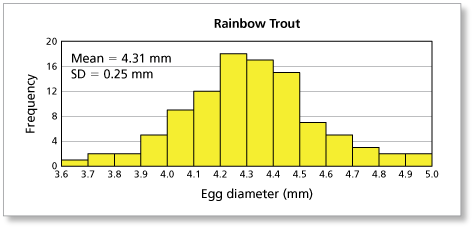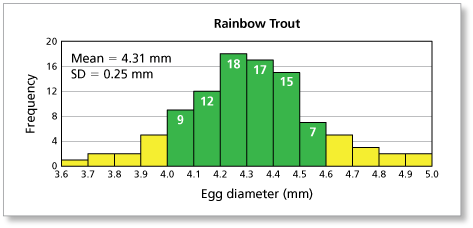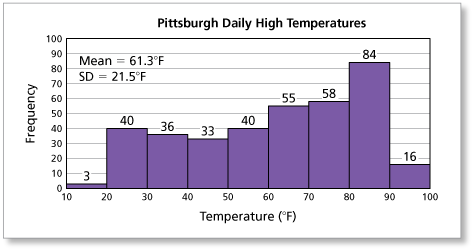-
The histogram shows the distribution of the diameters of 100 rainbow trout eggs. Describe the dispersion. (See Example 1 and Example 2.)

-
The mean is about 4.3 millimeters and the standard deviation is about 0.3 millimeter. Add the number of egg diameters that are in the range from 4.0 millimeters to 4.6 millimeters.

About 78 egg diameters lie within 1 standard deviation of the mean.

Comments (0)These comments are not screened before publication. Constructive debate about the information on this page is welcome, but personal attacks are not. Please do not post comments that are commercial in nature or that violate copyright. Comments that we regard as obscene, defamatory, or intended to incite violence will be removed. If you find a comment offensive, you may flag it.
When posting a comment, you agree to our Terms of Use.Showing 0 commentsSubscribe by email Subscribe by RSSThere are no comments. -
-
The histogram shows the distribution of the diameters of 100 rainbow trout eggs. What percent of the diameters lie within 2 standard deviations of the mean? (See Example 1 and Example 2.)

These comments are not screened before publication. Constructive debate about the information on this page is welcome, but personal attacks are not. Please do not post comments that are commercial in nature or that violate copyright. Comments that we regard as obscene, defamatory, or intended to incite violence will be removed. If you find a comment offensive, you may flag it.
When posting a comment, you agree to our Terms of Use. -
The histogram shows the distribution of the diameters of 100 rainbow trout eggs. What percent of the diameters lie within 3 standard deviations of the mean? (See Example 1 and Example 2.)

-
The mean is about 4.3 millimeters and the standard deviation is about 0.3 millimeter. Data values that lie within 3 standard deviations lie within the range 4.3 - 3(0.3) to 4.3 + 3(0.3), or from 3.4 millimeters to 5.2 millimeters. Because all of the data values lie within that range, you can say that 100% of the data lie within 3 standard deviations of the mean.
These comments are not screened before publication. Constructive debate about the information on this page is welcome, but personal attacks are not. Please do not post comments that are commercial in nature or that violate copyright. Comments that we regard as obscene, defamatory, or intended to incite violence will be removed. If you find a comment offensive, you may flag it.
When posting a comment, you agree to our Terms of Use. -
-
The histogram shows the distribution of the daily high temperatures of Pittsburgh for 2010. Describe the dispersion. (See Example 1 and Example 2.)

These comments are not screened before publication. Constructive debate about the information on this page is welcome, but personal attacks are not. Please do not post comments that are commercial in nature or that violate copyright. Comments that we regard as obscene, defamatory, or intended to incite violence will be removed. If you find a comment offensive, you may flag it.
When posting a comment, you agree to our Terms of Use. -
The histogram shows the distribution of the daily high temperatures of Pittsburgh for 2010. What percent of the temperatures lie within 1 standard deviation of the mean? (See Example 1 and Example 2.)

-
The mean is about 60°F and the standard deviation is about 20°F. Add the number of temperatures that are in the range from 40°F to 80°F.

Then divide by the total number of temperatures. Because 2010 was not a leap year, there were 365 days and thus a total of 365 daily temperatures. (Alternatively, you can add all of the bar heights in the histogram to reach a total number of 365 daily temperatures.)

So, about 51% of the temperatures lie within 1 standard deviation of the mean.
These comments are not screened before publication. Constructive debate about the information on this page is welcome, but personal attacks are not. Please do not post comments that are commercial in nature or that violate copyright. Comments that we regard as obscene, defamatory, or intended to incite violence will be removed. If you find a comment offensive, you may flag it.
When posting a comment, you agree to our Terms of Use. -
-
The histogram shows the distribution of the daily high temperatures of Pittsburgh for 2010. What percent of the temperatures lie within 2 standard deviations of the mean? (See Example 1 and Example 2.)

These comments are not screened before publication. Constructive debate about the information on this page is welcome, but personal attacks are not. Please do not post comments that are commercial in nature or that violate copyright. Comments that we regard as obscene, defamatory, or intended to incite violence will be removed. If you find a comment offensive, you may flag it.
When posting a comment, you agree to our Terms of Use.





